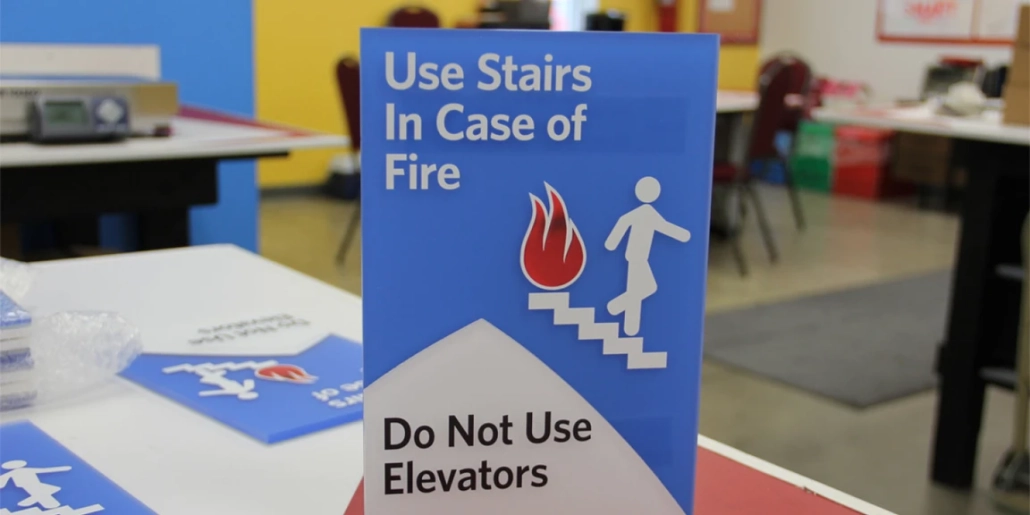Signarama
With more than three decades of experience and more locations around the world than anyone else, Signarama is the leading innovator in the signs & graphics industry.
Our experts specialize in bringing your business to life through branded visuals throughout your building and beyond. If you can imagine it, we can do it. From concept to completion, our sign experts can create, design, produce and install quality signage that will help your business make a lasting impression.
Emergency Preparedness Using Signage to Improve Community Safety
During emergencies and in times of crisis, effective communication between citizens and local governments is critical. Local governments, police, fire, and emergency response agencies should play a crucial role in informing and protecting communities by utilizing clear, informative signage. From identifying evacuation routes and shelter locations, to educating the public about emergency protocols, effective signage provides a much-needed lifeline for citizens during these chaotic situations.
This month, Signarama explores how response agencies can leverage signage to enhance public safety during emergencies and crises, comparing these strategies to the successful use of signs during the COVID-19 pandemic. Drawing on lessons learned, this article will highlight the importance of clear, consistent messaging in public safety signage.
The Role of Signage in Emergency Response
Public safety signage should serve as an immediate and reliable source for information that impacts community members during emergencies. The effectiveness of emergency signage lies in its ability to provide clear, concise, and actionable information quickly. Emergency signage can take many forms, including:
-
Evacuation Routes
While different states and governments use different colors for evacuation route signs, yellow and orange are generally used for cautionary signage that direct people to the safest routes out of danger zones, such as those used before hurricanes or during wildfires or floods. These signs must be highly visible, reflective, and positioned strategically to guide people swiftly and safely out of harm’s way.
-
Emergency Shelter Locations
In order to locate the nearest emergency shelter, many shelter signs are designed using symbols and arrows for quick recognition, and can prove vital during extreme weather events, such as tornadoes, or man-made disasters, such as chemical spills, industrial explosions and forest fires, or in the event of terrorist attacks.
-
Crisis Communication
For the most efficient communications, law enforcement and emergency responders can update digital displays remotely, in real-time to inform citizens of changes in crisis situations, such as new hazards, road closures, or additional shelter openings. While not as immediate as digital displays, local emergency responders can update temporary signage as conditions warrant.
Health and Safety Instructions
During the COVID-19 pandemic, public health was significantly impacted by health and safety instruction signage. In health-related crises like pandemics, signage can communicate safety protocols, including highlighting hygiene practices, and providing social distancing guidelines.
Public safety signage is designed to allow for instantaneous dissemination of critical information, especially when other communication methods, such as cell towers or the internet are compromised. The key to effective health and safety instructional signage is clarity, because when people are in panic mode, they need simple instructions that are easy to follow.
What We Learned from Pandemic Signage
During the COVID-19 pandemic, instructional safety signage functioned as the central tool for educating the public and reminding citizens to comply with health measures. Instructional safety signage was deployed across the US and the globe in various forms:
-
Social Distancing Markers
Clearly demarcated areas in public spaces and essential businesses helped maintain physical distancing. Floor decals and arrows marked social distancing protocols outside as well as inside many stores and businesses.
-
Directional Signage
In grocery stores and other high-traffic businesses, directional signs and arrows controlled the flow of foot traffic in store aisles, minimizing close contact.
-
Health Protocols
During the pandemic, window graphics, wall murals, A-frames, post and panel signs and billboards constantly reminded people to wear masks, wash their hands, and avoid large gatherings.
One of the key successes of pandemic signage was its ubiquitous and consistent nature. Local governments, health departments, and businesses all aligned on common messaging. Symbols and images played a significant role in breaking down language barriers, making these signs accessible to everyone, regardless of their language skills.
Moreover, dynamic digital signage played a major role in allowing for updates as new information became available. This flexibility ensured the public was always updated to the most current guidance, even as health recommendations evolved. Digital signage’s ability to readily update messaging has already changed how corporations, education, and other industries communicate as a whole. In rapidly changing conditions, such as active shooter alerts, updates on fire containment, shelter capacities and more, digital signage can provide the most effective communications in an emergency.
Applying Pandemic Lessons to Emergency Signage
Emergency preparedness signage can benefit from the successes of pandemic strategies in several ways:
-
Consistency in Messaging
Just as pandemic signage provided clear, consistent health guidelines, emergency signage should offer simple, uniform instructions across various channels. Whether directing people to an evacuation route or providing health and safety information, straightforward messaging is required.
-
Inclusive Design
Much like the pandemic-era use of images, charts, and universal symbols, emergency signage should be accessible to all community members, including those with limited language skills or disabilities. ADA-compliant signs with tactile and Braille components are essential for inclusivity, ensuring that everyone, including people with visual impairments can receive vital information.
-
Real-Time Updates
Leveraging technology, such as digital signage allows emergency response agencies to update information in real time. For example, during a hurricane evacuation, routes may change depending on road conditions, and digital signs can instantly reflect those updates. Similarly, pandemic signage evolved as health guidelines shifted, teaching us the value of flexible communication tools.
-
Visibility and Durability
Constructed of durable materials to withstand harsh weather conditions, public safety officials need to strategically place safety and warning signs in high-traffic, highly visible locations. This ensures that during natural disasters, such as floods or hurricanes, signs remain intact and legible.
Building a Holistic Approach to Crisis Communication
To maximize the impact of signage during emergencies, local governments and public safety agencies should integrate emergency signage into a broader crisis communication strategy. This could include:
-
Pre-Crisis Education
Proactive education campaigns familiarize community members with evacuation routes, emergency shelters, and crisis protocols long before a disaster occurs.
-
Signage Drills
Conducting drills with emergency signage in place can help communities practice the appropriate way to respond in real-life scenarios, reducing panic when a crisis strikes, similar to fire drills.
-
Feedback and Adjustment
Just as pandemic signage evolved based on public compliance and feedback, emergency response signage should be adaptable. Agencies should evaluate the effectiveness of their signage strategies and make adjustments where necessary.
Using direct, straightforward signage in emergency response situations is an essential tool for keeping communities informed and safe, during dramatic weather events as well as man-made crises. Drawing from the lessons learned during the COVID-19 pandemic, emergency response agencies can improve their crisis communication strategies by ensuring consistency, inclusivity, real-time updates, and visibility. As our world faces increasingly frequent and diverse crises, from natural disasters to public health emergencies, effective signage remains one of the most reliable ways to communicate essential information when it is needed most.
At Signarama, our sign professionals can help improve your crisis communication strategies, with compliant and durable signage, and digital displays that ensure the effectiveness of your emergency signage in future crises situations.



